Aurora Borealis
Episode #6 of the course “Rare and Unusual Weather Phenomena”
Auroras are named for the Roman goddess of the sunrise, and it is easy to see why. Natural light displays caused by charged particles in the earth’s atmosphere in the Arctic and Antarctic regions are known as the Aurora Borealis, or “Northern Lights,” and the Aurora Australis, or “Southern Lights.” Occurring high in the earth’s atmosphere, the Aurora Borealis typically occurs about 60 miles above the earth’s surface.
In the Arctic Circle, the Aurora Borealis gives a brilliant display that ranges from shades of green to yellow or pink to red or blue. The different colors are caused by the different types of particles breaking down in different layers of the atmosphere, which is why they change daily or even as an observer watches them. Photographs often show more red in the auroras than observers report, because film captures light differently than the human eye.
Ancient legends from Eskimos and Native Americans explain the Aurora Borealis as a kind of crack in the sky through which spirits pass to the heavens. Those heavenly spirits, called “selamiut” or “sky-dwellers,” light torches to guide new spirits bound for heaven. The natives say that observers can watch the spirits play football (soccer) with a walrus skull, and that any sounds that accompany the aurora are voices of the spirits and should always be answered in a whisper.
Although a spectacular auroral event received international fame as early as 1859, it was nearly a century before researchers found out more about them. In 1960, scientists first began studying the origins of the auroras, and over the past 55 years many discoveries have been made about how magnetism, geothermal activity, and solar flares affect the aurora.
Share with friends

